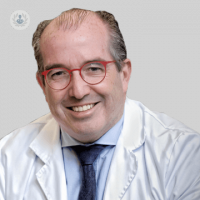Nuevas soluciones para el ronquido y las apneas
Written by:The doctor. González Lagunas, a prestigious specialist in Oral and Maxillofacial Surgery, offers details on the advances in the approach to snoring and sleep apnea. The doctor. González is an expert in cases of temporomandibular joint, orthognathic surgery, pre-prosthesis surgery, dental implants and rhinoplasty. He is currently head of service and medical director of Oral and Maxillofacial Surgery at QMaxDental, Hospital Quirón de Barcelona.
If there is something that can especially ruin our rest is undoubtedly the sound of a snore. It may seem unimportant but for those who have it is a really serious problem, both for him and for his partner. Not being able to rest during the night can cause during the day, we have a unique symptomatology, presenting: excessive sleepiness, fatigue or feeling of unrepairable sleep, headache, irritability, difficulty concentrating, memory loss or changes in the character.
What is snoring and why is it produced? What is OSA and what is it?
The noise of the snoring is produced by the vibration of the soft parts of the oropharynx. The passage of air through the throat vibrates surrounding tissues because they are "flaccid" or tense due to muscle rest and tongue fall, or because of the large amount of fatty tissue in the throat. This is what is called simple snoring .
However, it should be noted that snoring is almost always accompanied by a more important disorder called OSAS or Obstructive Sleep Apnea Syndrome. This syndrome affects 4-6% of men and between 2 and 4% of women of average age, which increases to one in those over 65 years.
OSAS is a serious sleep disorder and consists of repeated episodes of upper airway obstruction during the deep sleep phase with breathing pauses between 10 and 30 seconds. This means that we stop introducing air into the lungs during those seconds while we are fast asleep. These breathing pauses are followed by an attempt to breathe and a change to a lighter sleep stage, as oxygenation decreases and we wake up for 1 and 3 seconds. In this way the dream stops being reparative because it fragments. It is for this reason that people with OSAS can also present snoring, apnea , episodes of asphyxia, frequent awakenings, insomnia and nightmares, restless sleep, need to urinate or gastroesophageal reflux .
It is worth mentioning that there are some causes or risk factors for OSAS, such as obesity (60% of OSAS patients are obese), obstruction of the respiratory tract through the tongue, tonsils or uvula. It can also be the consumption of tobacco and alcohol, the use of medicines to sleep or to lie supine to sleep.

How to diagnose Sleep Apnea Syndrome or OSAS
The diagnosis of OSAS is established with polysomnography , tests indicated in people who present one or more of the following symptoms:- Drowsiness, unrefreshing sleep or fatigue- Waking up with a feeling of shortness of breath or choking- When a witness describes: habitual snoring and interruptions of breathing during sleep- History of: arterial hypertension, mood disorders, coronary artery disease, myocardial infarction or Type II Diabetes Mellitus
How to treat snoring and OSAS?
The treatment of Sleep Apnea Syndrome will vary according to the case, regardless of the degree of severity of the disorder, experts in Oral and Maxillofacial Surgery establish some common recommendations:- Losing weight, in case of obesity- Sleep on your side or face down instead of on your back- Avoid smoking, alcohol and sedatives before going to sleep- Try to eat 2-3 hours before bedtime
The treatments are usually effective, and include:1) Mandibular advancement deviceThey are two splints united to each other by means of a screw, that allows to advance the mandible and increases the muscular tone at the level of the airway. The use of these splints facilitates the passage of air and eliminates snoring, improves episodes of apnea and, therefore, improves the quality of life (and rest) of the patient.
The advancement of the mandible is performed in a controlled manner and will depend on the ability of each patient to advance his jaw. The aim is to make it as comfortable as possible for the patient and, during use, you can make sideways movements as well as open your mouth slightly.
2) Maxillomandibular advancementIt is a surgical intervention that consists of simultaneously advancing the maxillary and mandibular bones , in order to extend the air space, both in the rhinopharynx (posterior part of the nose) and in the oropharynx (posterior part of the mouth).
The operation is performed inside the mouth, without external scars. It consists of performing controlled osteotomies in the bones of the face, to move them forward (generally of the order of 1cm) and then fix them with screws and plates.
It is the treatment with better results, with a percentage of resolution of total sleep apneas in most cases.


